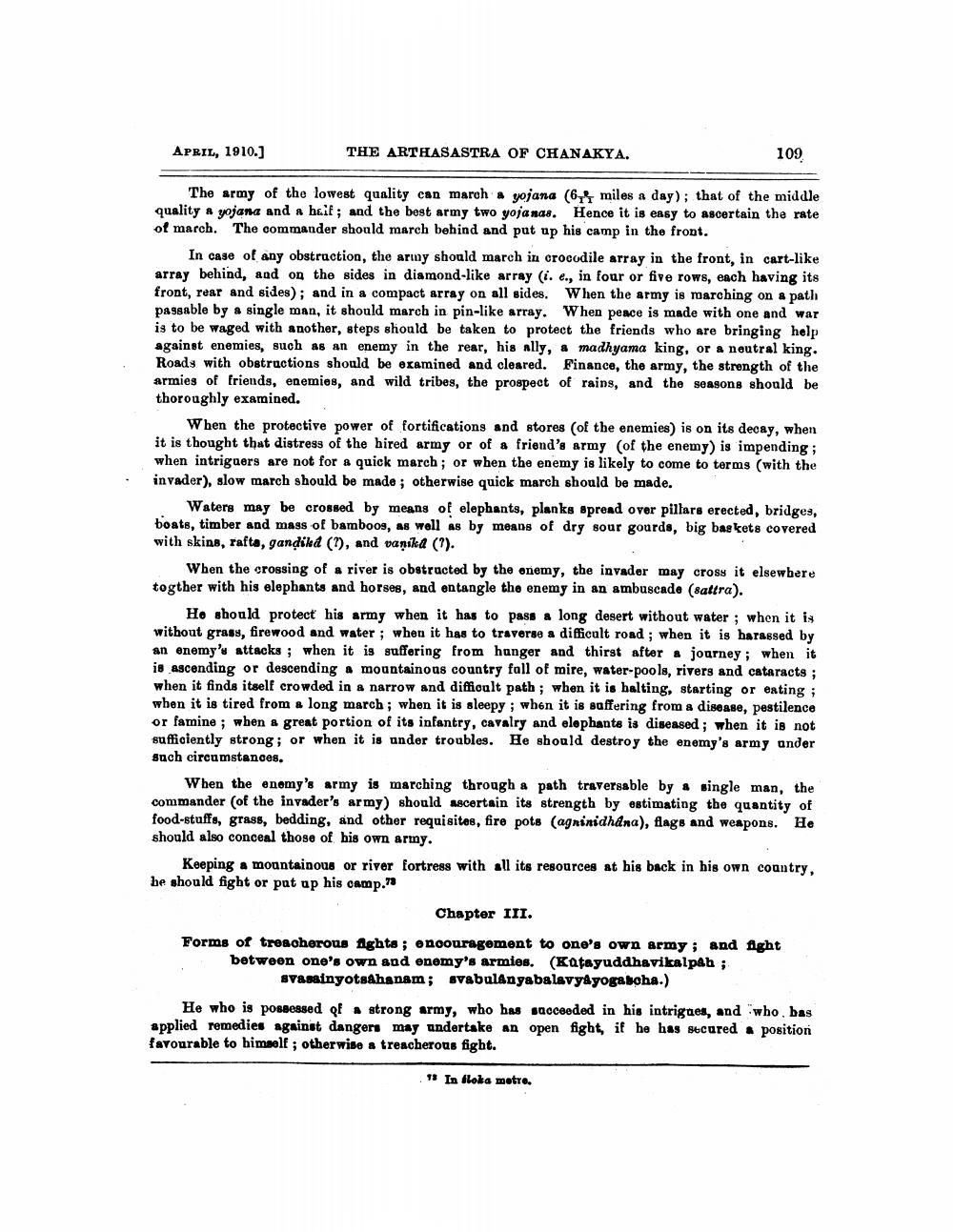________________
APRIL, 1910.]
THE ARTHASASTRA OF CHANAKYA.
109
The army of the lowest quality can march a yojana (6 miles a day); that of the middle quality a yojana and a half; and the best army two yojanas. Hence it is easy to ascertain the rate of march. The commander should march behind and put up his camp in the front.
In case of any obstruction, the army should march in crocodile array in the front, in cart-like array behind, and on the sides in diamond-like array (i. e., in four or five rows, each having its front, rear and sides); and in a compact array on all sides. When the army is marching on a path passable by a single man, it should march in pin-like array. When peace is made with one and war is to be waged with another, steps should be taken to protect the friends who are bringing help against enemies, such as an enemy in the rear, his ally, a madhyama king, or a neutral king. Roads with obstructions should be examined and cleared. Finance, the army, the strength of the armies of friends, enemies, and wild tribes, the prospect of rains, and the seasons should be thoroughly examined.
When the protective power of fortifications and stores (of the enemies) is on its decay, when it is thought that distress of the hired army or of a friend's army (of the enemy) is impending; when intriguers are not for a quick march; or when the enemy is likely to come to terms (with the invader), slow march should be made; otherwise quick march should be made.
Waters may be crossed by means of elephants, planks spread over pillars erected, bridges, boats, timber and mass of bamboos, as well as by means of dry sour gourds, big baskets covered with skins, rafts, gandikd (?), and vanika (?).
When the crossing of a river is obstructed by the enemy, the invader may cross it elsewhere togther with his elephants and horses, and entangle the enemy in an ambuscade (sattra).
He should protect his army when it has to pass a long desert without water; when it is without grass, firewood and water; when it has to traverse a difficult road; when it is harassed by an enemy's attacks; when it is suffering from hunger and thirst after a journey; when it is ascending or descending a mountainous country fall of mire, water-pools, rivers and cataracts; when it finds itself crowded in a narrow and difficult path; when it is halting, starting or eating; when it is tired from a long march; when it is sleepy; when it is suffering from a disease, pestilence or famine; when a great portion of its infantry, cavalry and elephants is diseased; when it is not sufficiently strong; or when it is under troubles. He should destroy the enemy's army under such circumstances.
When the enemy's army is marching through a path traversable by a single man, the commander (of the invader's army) should ascertain its strength by estimating the quantity of food-stuffs, grass, bedding, and other requisites, fire pots (agninidhana), flags and weapons. He should also conceal those of his own army.
Keeping a mountainous or river fortress with all its resources at his back in his own country, he should fight or put up his camp."
Chapter III.
Forms of treacherous fights; encouragement to one's own army; and fight between one's own and enemy's armies. (Katayuddhavikalpah ; svasainyotsahanam; svabulanyabalavyayogascha.)
He who is possessed of a strong army, who has succeeded in his intrigues, and who bas applied remedies against dangers may undertake an open fight, if he has secured a position favourable to himself; otherwise a treacherous fight.
13 In floka metre.




